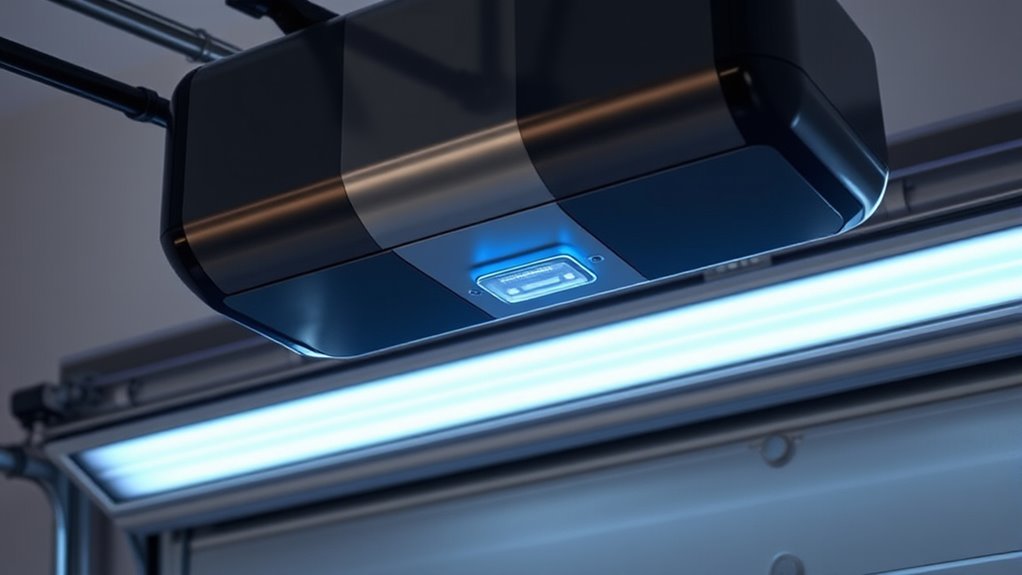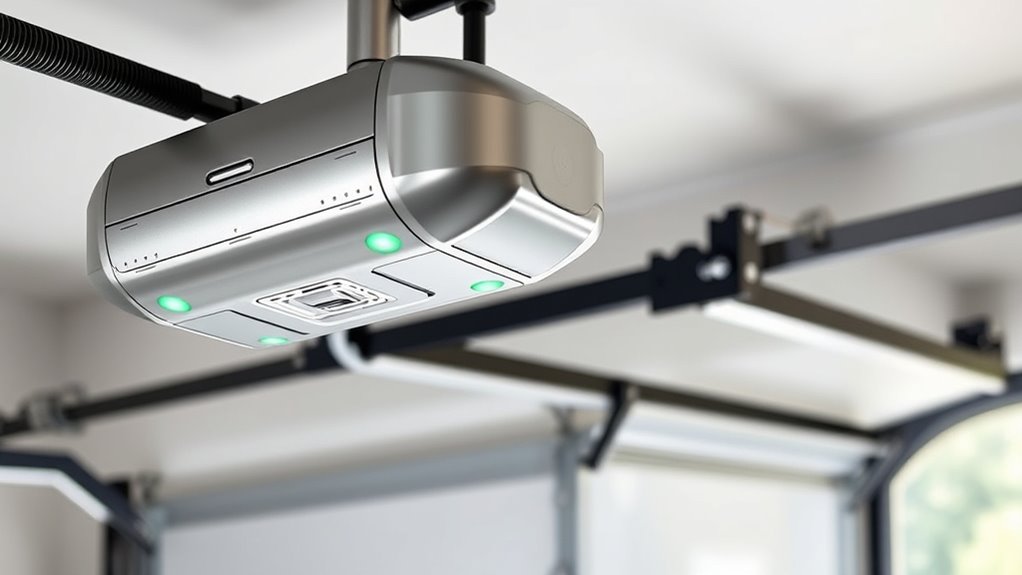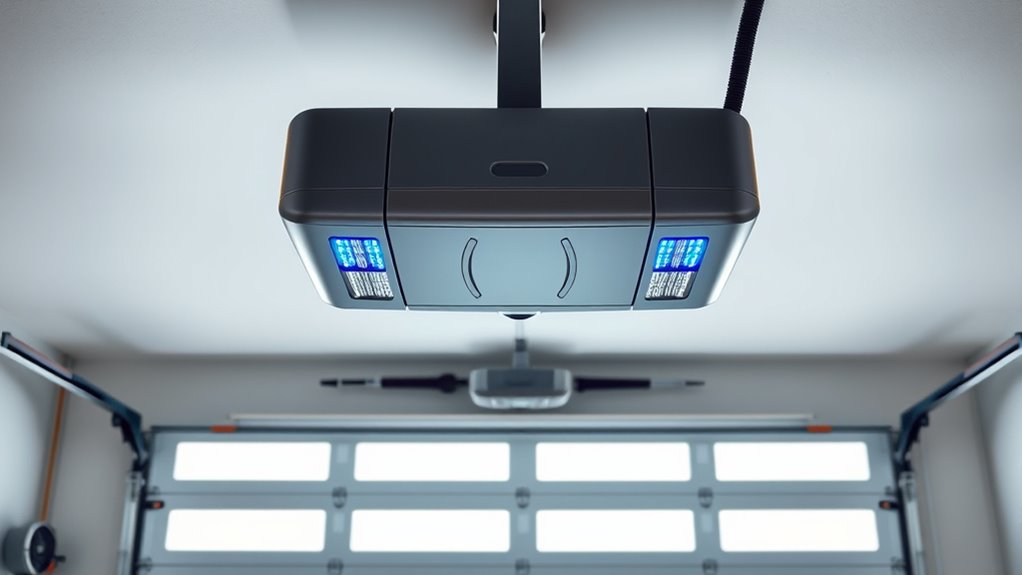Smart garage door openers with safety sensors let you control your garage remotely using Wi-Fi or Bluetooth, while infrared sensors detect obstructions and prevent accidents. They integrate with voice assistants and smart home systems for easy operation and enhanced security. Advanced features include code encryption, tamper alerts, and activity logs to keep your home safe. Keep exploring to discover how these innovative systems can improve your home’s convenience and security even further.
Key Takeaways
- Modern smart garage door openers offer Wi-Fi, Bluetooth, and voice control for remote and hands-free operation.
- Safety sensors use infrared beams to detect obstacles, preventing accidents and door damage.
- Connectivity features enable monitoring, scheduling, and alerts via smartphone apps and integrate with popular smart home platforms.
- Security protocols like rolling codes and encryption protect against hacking, code interception, and unauthorized access.
- Proper installation and regular maintenance ensure reliable operation, safety, and effective integration with smart home systems.
Understanding the Features of Smart Garage Door Openers

Smart garage door openers offer a range of advanced features that make managing your garage more convenient and secure. With Wi-Fi connectivity, you can control your door remotely using smartphone apps from anywhere with internet access. Some models support Bluetooth, providing close-range control without Wi-Fi but limited remote access. Integration with voice assistants like Amazon Alexa, Google Home, and Apple HomeKit allows you to operate your garage door with simple voice commands. Geofencing technology enables automatic opening or closing based on your location, adding convenience. Backup options, such as batteries and manual controls, guarantee operation during power outages. These features work together to enhance your garage’s security and ease of use, making smart openers a practical upgrade for your home.
How Safety Sensors Enhance Garage Door Security

Safety sensors markedly boost your garage door’s security by preventing accidents and deterring unauthorized entry. Infrared beam sensors act as invisible tripwires, detecting objects, pets, or people in the door’s path. When an obstruction is sensed, the door stops closing and reverses, reducing injury and property damage. Modern sensors can identify even small obstacles, enhancing safety, especially in homes with kids or pets. They also help meet safety standards, lowering liability risks. For security, sensors detect tampering attempts or forced openings, triggering alarms or alerts. Integration with home security systems allows real-time monitoring of garage access, acting as a deterrent for intruders. Overall, safety sensors add an essential layer of protection, making your garage safer and more secure against accidents and unauthorized entry. Enhanced protection against accidents Additionally, upgraded sensors function reliably under challenging environmental conditions like extreme temperatures and humidity, ensuring consistent safety performance over time. Moreover, advances in AI Security contribute to improved detection accuracy and reduce false alarms, further enhancing safety and reliability. Implementing these sensors aligns with environmental considerations by promoting energy efficiency and safety standards.
The Role of Connectivity and Smart Home Integration

Connectivity technology has transformed garage door openers by enabling seamless integration with your home’s digital ecosystem. Wi-Fi-enabled motors connect your garage door to the internet, letting you operate and monitor it remotely through smartphone apps. Bluetooth sensors provide precise door position updates, ensuring you always know if it’s open or closed. Controllers can connect to existing command nodes via wiring, making upgrades straightforward. Reliable 2.4 GHz Wi-Fi coverage inside your garage is essential for consistent performance. Smartphone apps allow you to open, close, schedule, and receive real-time notifications about your garage door’s status. Many systems also integrate with popular smart home platforms like Google Assistant, Amazon Alexa, and Apple HomeKit, giving you voice control and centralized management of all your devices. Proper network setup ensures your smart garage system functions reliably and securely, and using secure Wi-Fi networks helps protect your connected devices from potential cyber threats.
Security Protocols and Code Systems for Safe Operation

To keep your garage door secure, advanced security protocols and code systems are essential. Modern systems use military-grade encryption combined with rolling code technology that changes codes with each use, making interception useless. Code hopping guarantees intercepted codes can’t be reused, preventing replay attacks. Communication between remote and opener is encrypted to guard against hacking or duplication. Compliance with electromagnetic standards guarantees security without interference. Automatic locks activate when the door closes, providing an extra layer of protection against forced entry. Additionally, some openers incorporate multi-factor authentication, requiring device verification and user validation for access. Activity logs and real-time alerts help monitor door activity, while features like geofencing and motion detection enhance security. High refresh rates and low input lag are also vital in ensuring quick response times for remote commands, contributing to overall safety. These protocols work together to ensure your garage remains protected from unauthorized access and tampering.
Tips for Easy Installation and Ongoing Maintenance

Proper planning is essential for a smooth garage door opener installation, so start by choosing a mounting location at least six feet above the ground near an electrical outlet—avoiding extension cords to guarantee safety and compliance. Before installing, verify your Wi-Fi signal is strong enough in the garage for reliable operation. Strong Wi-Fi connection is vital for the seamless functioning of smart garage systems and can help prevent connectivity issues. Clean and dry the mounting surface to ensure adhesives or screws hold securely. Gather tools like a ladder, drill, screwdriver, pencil, and safety glasses. Plan wire routing along existing wires or rafters to minimize exposed wiring and prevent damage. During installation, unplug the garage door opener for safety, then mount the controller using adhesive or screws, keeping it near the opener and power source. Connect the cables, mount safety sensors, and test the system thoroughly for smooth, safe operation. Incorporating automation’s role in business intelligence can also help monitor system performance and identify potential issues early.
Frequently Asked Questions
How Do Smart Openers Handle Multiple Users’ Access Permissions?
You can manage multiple users’ access permissions through guest invitations, role assignments, or advanced control features. You send invitations for limited access or assign specific roles like owner, manager, or guest, each with different privileges. Some systems let you schedule or restrict access, revoke permissions anytime, and monitor activity. This way, you keep control, enhance security, and tailor access for each user without sharing passwords or risking unauthorized entry.
What Backup Options Are Available if Wi-Fi Connectivity Fails?
If Wi-Fi fails, you can still operate your garage door using a manual release cord, allowing you to open or close it physically. For example, during a power outage, a homeowner uses the manual lever to access their garage. Additionally, a wired wall control or traditional remote control works offline, and some models support Bluetooth control via smartphone apps, ensuring you stay connected even when Wi-Fi is down.
Can Safety Sensors Differentiate Between Pets and Obstacles?
Safety sensors generally can’t tell pets from other obstacles. They detect movement or obstructions in the door’s path but don’t classify what causes the interruption. You might get false alarms with small objects or pets, but the system won’t identify them specifically. To protect your pets, consider physical barriers like rubber seals or custom door settings, rather than relying solely on sensors for pet-specific safety.
Are There Specific Smart Home Platforms Compatible With All Models?
You won’t find a smart home platform that supports every garage door model—it’s like chasing a unicorn! Most platforms, like Amazon Alexa, Google Assistant, and Samsung SmartThings, work with many popular openers, but compatibility depends on your device’s hardware and protocols. Always double-check manufacturer lists and your garage door’s features before buying. This guarantees seamless integration, so you can control your garage effortlessly across your preferred smart home ecosystem.
How Do I Troubleshoot False Alarms From Safety Sensors?
To troubleshoot false alarms from safety sensors, start by inspecting the sensor lenses for dirt, dust, or obstructions and clean them gently. Check the sensor alignment with a spirit level or by visually ensuring they face each other directly. Examine wiring for damage or looseness, and verify the LED indicators are steady green. Finally, remove nearby objects or heat sources that might interfere with sensor signals, and test the system again.
Conclusion
While smart garage door openers bring convenience and advanced security, neglecting safety sensors can turn ease into risk. Imagine enjoying seamless connectivity, only to face unexpected accidents or breaches. Balancing high-tech features with proper safety measures guarantees your garage remains both smart and secure. Don’t let cutting-edge gadgets give you a false sense of security—embrace the technology, but stay vigilant. After all, the true safety of your home depends on smart choices, not just smart devices.









